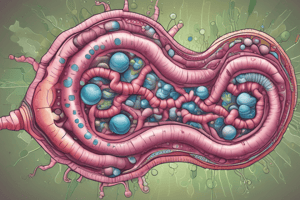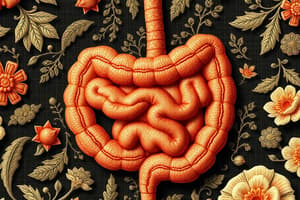Podcast
Questions and Answers
What is the primary function of lingual lipase in the initial stages of digestion?
What is the primary function of lingual lipase in the initial stages of digestion?
- To facilitate the absorption of cholesterol in the stomach.
- To synthesize new triglycerides from absorbed lipids.
- To emulsify large lipid drops into smaller droplets.
- To break down triglycerides into monoglycerides and fatty acids. (correct)
Why is the emulsification of lipids by bile salts important for lipid digestion?
Why is the emulsification of lipids by bile salts important for lipid digestion?
- It neutralizes the acidic environment of the stomach.
- It increases the solubility of lipids in the intestinal lumen.
- It directly transports lipids into the intestinal cells.
- It provides a larger surface area for pancreatic lipase to act on. (correct)
What are micelles and what role do they play in lipid absorption?
What are micelles and what role do they play in lipid absorption?
- They are protein coats that surround triglycerides for transport in blood.
- They are lipid-bile salt complexes that transport digested lipids to the intestinal epithelium. (correct)
- They are enzymes that break down triglycerides.
- They are hormones that stimulate the release of pancreatic lipase.
What is the function of chylomicrons in the context of lipid digestion and absorption?
What is the function of chylomicrons in the context of lipid digestion and absorption?
Why do chylomicrons enter the lacteals of the lymphatic system rather than diffusing directly into blood capillaries?
Why do chylomicrons enter the lacteals of the lymphatic system rather than diffusing directly into blood capillaries?
How does the acidic environment of the stomach affect the activity of lingual lipase?
How does the acidic environment of the stomach affect the activity of lingual lipase?
What stimulates the release of CCK (cholecystokinin) and what is its role in lipid digestion?
What stimulates the release of CCK (cholecystokinin) and what is its role in lipid digestion?
After lipids diffuse into intestinal epithelial cells, what happens to the monoglycerides, fatty acids, and glycerol?
After lipids diffuse into intestinal epithelial cells, what happens to the monoglycerides, fatty acids, and glycerol?
What is the approximate percentage of triglycerides broken down in the stomach before chyme moves into the duodenum?
What is the approximate percentage of triglycerides broken down in the stomach before chyme moves into the duodenum?
Which enzyme is primarily responsible for breaking down triglycerides into fatty acids, monoglycerides, and glycerol in the small intestine?
Which enzyme is primarily responsible for breaking down triglycerides into fatty acids, monoglycerides, and glycerol in the small intestine?
If a person's gallbladder is removed, how would this affect their ability to digest and absorb fats?
If a person's gallbladder is removed, how would this affect their ability to digest and absorb fats?
A patient is diagnosed with a deficiency in pancreatic enzyme secretion. How would this condition most likely affect lipid digestion?
A patient is diagnosed with a deficiency in pancreatic enzyme secretion. How would this condition most likely affect lipid digestion?
What would happen if the intestinal cells were unable to synthesize triglycerides from monoglycerides, fatty acids, and glycerol?
What would happen if the intestinal cells were unable to synthesize triglycerides from monoglycerides, fatty acids, and glycerol?
In a scenario where a patient has impaired lacteal function, how would the absorption of lipids be affected?
In a scenario where a patient has impaired lacteal function, how would the absorption of lipids be affected?
A drug inhibits the production of bile salts in the liver. What direct effect would this have on fat digestion?
A drug inhibits the production of bile salts in the liver. What direct effect would this have on fat digestion?
What is the initial step in lipid digestion that occurs in the oral cavity?
What is the initial step in lipid digestion that occurs in the oral cavity?
Which process is directly facilitated by the mechanical action of chewing in the mouth?
Which process is directly facilitated by the mechanical action of chewing in the mouth?
How does the transport of lipids differ from the transport of carbohydrates and proteins after absorption from the small intestine?
How does the transport of lipids differ from the transport of carbohydrates and proteins after absorption from the small intestine?
What is the role of exocytosis in the absorption of dietary fats?
What is the role of exocytosis in the absorption of dietary fats?
If a person has a genetic defect that prevents the formation of micelles, what would be the most likely consequence?
If a person has a genetic defect that prevents the formation of micelles, what would be the most likely consequence?
Flashcards
Lingual Lipase
Lingual Lipase
Enzyme found in saliva that initiates the breakdown of triglycerides into monoglycerides and fatty acids in the mouth.
Emulsification
Emulsification
Process in the duodenum where bile salts break large lipid drops into smaller droplets, increasing the surface area for enzyme action.
Pancreatic Lipase
Pancreatic Lipase
Enzyme secreted by the pancreas into the duodenum to further break down triglycerides into fatty acids, monoglycerides, and glycerol.
Micelle
Micelle
Signup and view all the flashcards
Chylomicrons
Chylomicrons
Signup and view all the flashcards
Chylomicron Secretion
Chylomicron Secretion
Signup and view all the flashcards
Lacteals
Lacteals
Signup and view all the flashcards
Study Notes
- Chewing breaks food into smaller pieces and disrupts connective tissues.
- Saliva containing lingual lipase saturates the bolus, which splits triglycerides into monoglycerides and fatty acids.
Lipid Digestion
- Dietary lipids are generally not water-soluble.
- Chyme mixing in the stomach forms large lipid drops.
- Lingual lipase functions in the acidic environment of the stomach but only breaks down triglycerides on the surface of lipid drops.
- Approximately 20% of triglycerides are broken down by the time chyme exits the stomach.
Role of CCK and Bile
- When chyme enters the duodenum, CCK is released, triggering secretion of pancreatic enzymes like pancreatic lipase.
- CCK also stimulates gallbladder contraction, releasing bile into the duodenum.
- Bile salts emulsify large lipid drops into smaller droplets for better pancreatic lipase access.
- Pancreatic lipase breaks triglycerides into fatty acids, monoglycerides, and glycerol.
- Released molecules interact with bile salts, forming lipid-bile salt complexes known as micelles.
Micelle and Lipid Absorption
- Micelles contact intestinal epithelium, and lipids diffuse across the plasma membrane into the cytosol.
- Intestinal cells synthesize new triglycerides from monoglycerides, fatty acids, and glycerol.
- These triglycerides combine with absorbed cholesterol, phospholipids, and other lipid-soluble materials, and are coated with proteins, forming chylomicrons.
Chylomicron Transport
- Intestinal cells secrete chylomicrons into interstitial fluid via exocytosis.
- The protein coating keeps chylomicrons suspended in interstitial fluid.
- Size of chylomicrons prevents them from diffusing into capillaries.
- Instead, chylomicrons diffuse into intestinal lacteals of the lymphatic system, which lack basement membranes and have gaps between endothelial cells.
Studying That Suits You
Use AI to generate personalized quizzes and flashcards to suit your learning preferences.




